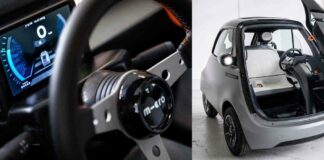Peugeot is known for pushing design boundaries, and their latest concept, the Polygon, doubles down on that legacy with a bold, angular look that’s all about embracing sharp edges. Previewed at the 2023 IAA Mobility show in Munich, this futuristic subcompact hints at the direction Peugeot’s popular 208 model might take. While some features are pure concept extravagance, the heart of the Polygon’s design — its steering system and overall boxy shape — points toward tangible changes coming to future Peugeots.
The most striking element is undoubtedly the “Hypersquare” steering wheel. Resembling an oversized gaming controller, this rectangular wheel made its debut on Peugeot’s 2023 Inception concept. Its return here signals that a production car wearing this unusual yoke will soon hit roads. The company even calls it “a tangible reality,” strongly suggesting we’ll see it in dealerships relatively soon.
This unconventional steering setup goes hand-in-hand with steer-by-wire technology. Peugeot plans to introduce this system on a production vehicle in 2027, ditching the traditional mechanical link between the wheel and the front wheels. Steer-by-wire allows for variable steering ratios that adapt to speed – tighter turns at low speeds and gentler inputs at higher ones. The Hypersquare’s rotation is limited to 170 degrees in each direction compared to a traditional wheel’s full 360 degrees, further emphasizing its unique operation.
Peugeot claims this combination improves maneuverability during parking or tight maneuvers while requiring minimal steering input at speed. While steer-by-wire isn’t entirely new – Infiniti debuted it over a decade ago on the Q50 – Peugeot believes their implementation surpasses existing systems in performance across all driving conditions.
While the Polygon embraces radical styling, like its dramatic gullwing doors and massive windscreen display, these features are likely to fade into concept car theatrics by the time they reach production form. The next-generation 208 will definitely draw inspiration from the Polygon’s angular aesthetic but in a more practical package.
Expect cues from the Polygon’s design language – particularly its boxy shape and squared-off details – to carry over into the new 208, though without the outlandish proportions. The production car is expected to retain rear doors for practicality, mirroring rivals like the Volkswagen Polo and SEAT Ibiza who have abandoned three-door configurations in favor of five-doors.
Peugeot hints that the Polygon’s retro touches, such as square taillights inspired by the iconic 205 GTi, might also find their way onto production models. This blend of modern design with nostalgic nods could become a recurring theme in Peugeot’s future vehicles. The concept’s compact size aligns well with the European subcompact category, and though it rides on an unconfirmed platform for now, rumors point to the STLA Small architecture shared with its Opel Corsa sibling.
Just as with current models, expect both combustion-engine and electric versions of the next 208 to cater to a wide range of customer preferences. Stellantis previously confirmed that the STLA Small platform supports EVs capable of reaching up to 500 kilometers (311 miles) on a single charge. The planned Spanish production facilities for this platform suggest that the new Peugeot 208 will be assembled in Vigo and Zaragoza, mirroring its predecessor’s manufacturing locations.
While the Polygon might seem like a futuristic leap from the current reality, certain elements clearly point to a future where Peugeots are both stylishly boxy and technologically advanced.























